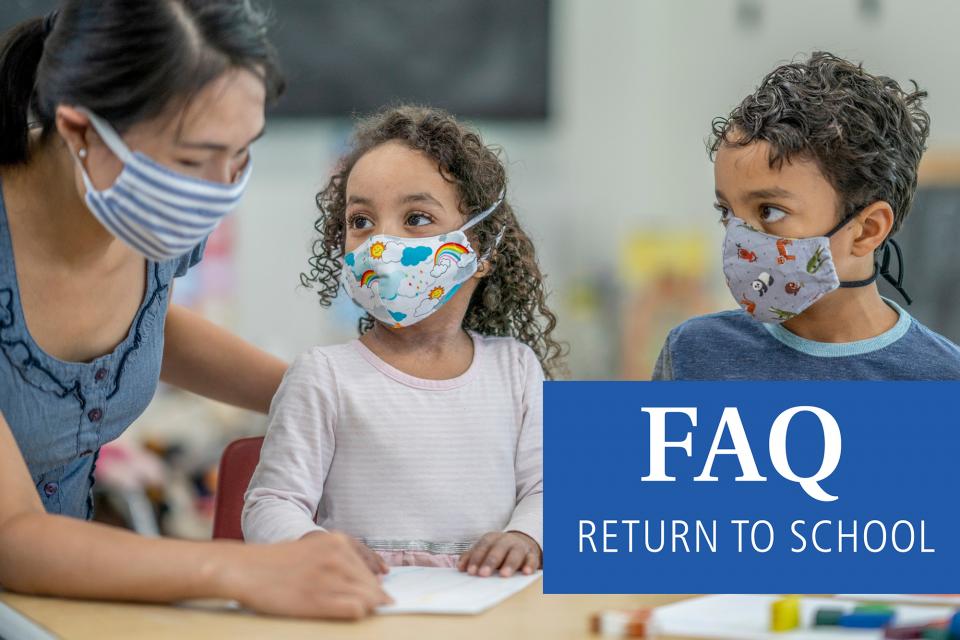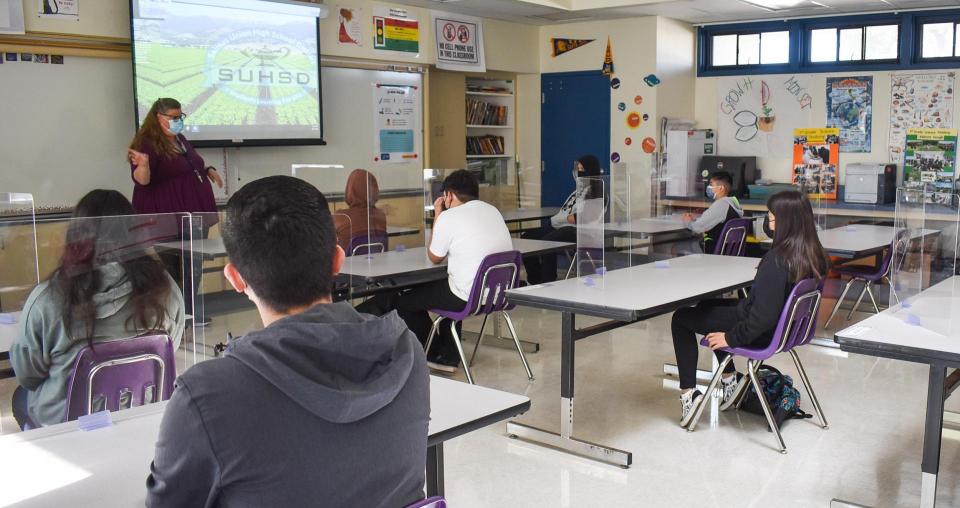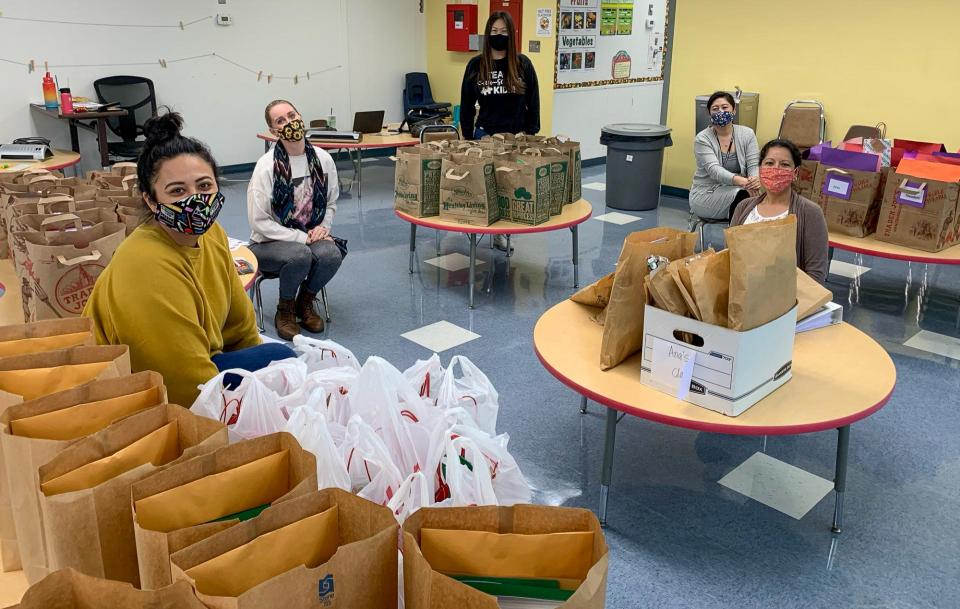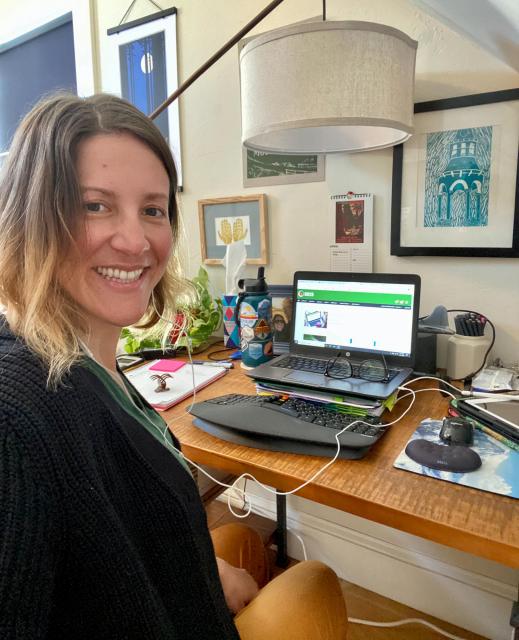Now that California schools have returned to in-person classes, teachers and staff on campuses up and down the state are having to navigate a new phase of the COVID-19 pandemic. In mid-August, the CFT held a tele-townhall meeting to connect directly with members and hear about your workplace concerns. Below are answers to the most common questions we heard from you.
1. What are the current physical distancing rules for schools and is it really safe?
The California school guidance for the 2021-22 school year removes most of the physical distancing requirements from last year because scientific evidence has shown in-person instruction can be safe without minimum distancing as long as other mitigation strategies, like masking, are in place. The California Public Health Department is consistent with the federal CDC guidance for schools, which recommends 3 feet of distancing when possible, and multiple layers of mitigation if it is not possible. The CDC also recommends at least 6 feet distance between students and teachers or staff, and between teachers or staff who are not fully vaccinated.
2. If there is no distancing requirement for young children at the elementary level, what else can we do to prevent COVID-19 transmission?
Until young children are eligible for COVID-19 vaccinations, the multiple layers of prevention strategies are especially important. In addition to masking, these measures can include screening testing, improved ventilation, handwashing, staying at home when experiencing any of the COVID-19 symptoms.
3. Are students required to physically distance during lunch when they have their masks off?
The California Department of Public Health school guidance recommends maximizing physical distance as much as posible when eating, especially indoors, and suggests using spaces in addition to the cafeteria — including outdoor spaces — to encourage distancing. The CDC recommends students wear masks when moving through food service lines. All staff doing food prep and service should be masked at all times, except when they are eating or drinking.
4. What resources are there for COVID testing at schools?
California has a comprehensive school testing program, which includes a K-12 school-based testing strategy, testing guidance, and significant state and federal funding available to schools. A public health order requies vaccine verification or weekly testing for all school staff to be in place by October 15. Some schools have additionally adopted vaccine mandates for employees and students.
5. I’m vaccinated, do I have to quarantine after being exposed at work? Do vaccinated students have to quarantine?
If you or your student are fully vaccinated (at least two weeks after the second shot of the Pfizer or Moderna vaccine or the single dose of the Johnson & Johnson vaccine), and you are identified as a close contact to someone with COVID-19, then you do not have to follow the quarantine recommendations as long as you are not experiencing any symptoms. However, the CDPH guidance for fully vaccinated people recommends testing 3-5 days after exposure and wearing a mask in public indoor settings for 14 days after exposure.
6. I’m not vaccinated, and I was exposed to COVID-19 at work. What quarantine protocols should I follow?
Staff who are exposed to COVID-19 at work are required to follow quarantine or isolation protocols. If you have any COVID-19 symptoms, you should self-isolate and follow the timeline, consulting with your healthcare provider if needed. If you have no symptoms, you should quarantine. Quarantines typically last 7-14 days and the duration of your quarantine period will depend on factors such as whether or not you have a negative COVID test and when the test was taken. Workplace exposures are governed by the rules in the Cal/OSHA Emergency Temporary Standards.
7. What about students who are not vaccinated — how long do they need to be in quarantine? What is modified quarantine?
There are two forms of quarantine for unvaccinated students who are exposed at school: standard and modified. The standard quarantine rules apply when students were not wearing masks when they were exposed to an infected individual or when the infected person was not wearing a mask during the exposure.
Under some circumstances, a modified quarantine can be followed, and this means the student who is exposed can attend in-person school but must quarantine for all other activiites (e.g., sports or extracurricular activities) and in the community. In addition, they must be asymptomatic, continue to mask, and undergo twice weekly testing during quarantine. To qualify for a modified quarantine, both parties must have been wearing a mask and the exposure must be in a school setting where students are supervised by school staff.
Note: Modified quarantine is only an option for students and only when the exposure occurs under school staff supervision. Staff cannot do a modified quarantine. Any person who is exposed as a close contact to an infectious person should isolate, not quarantine.
The duration of either quarantine period depends on when testing occurs. The K-12 school guidance and FAQ have full details and this summary from the California Department of Education has additional, easy to follow information about quarantine.\
8. How will we teach the students who are at home for quarantine? What plans are there for students who need to quarantine?
The CDE has a webpage with resources that clarify options for student learning during quarantine. This school year, there is a “Short-Term Independent Study” option that can be used to provide instruction for students who are quarantining. The CFT Legislative Department compiled a summary of the Independent Study rules for this year. Remember, in some schools, there may be additional considerations negotiated in MOUs, so there can be differences from place to place.
9. Are there indicators in place that would trigger a return to distance learning if COVID cases rise?
There is very little to no in-school transmission being documented in our state, thanks to the high vaccination rates, testing, and masking. There are no overarching indicators that will trigger a return to full distance learning and the CDPH views temporary school closure due to COVID-19 as a last resort. In some situations, local health officials could recommend a temporary school closure (see question 19 in the CDPH FAQ). COVID cases in California are not rising at this time, and hopefully will continue to decline as younger children become eligible for vaccination.
10. When are vaccinations going to available for all students?
On September 28, Pfizer-BioNTech submitted vaccine data on children ages 5-11 to the FDA and said it would request emergency use authorization within the coming weeks. The FDA has not said how long their review will take but suggested weeks rather than months. The CDC’s Dr. Anthony Fauci is hoping the first vaccines can be administered to this group by the end of October. Later this year, Pfizer expects to have data from its trials with children younger than age 5.
11. How is the state going to accommodate religious and medical exemptions to the vaccine requirement in schools?
The state public health order from August 11, 2021, requires TK-12 public and private schools to verify the vaccination status of all workers. Those who are not vaccinated are required to undergo weekly testing, and there are no exemptions included in this policy.
However, on October 1, the governor announced a statewide vaccine requirement for all students and staff in public and private K-12 schools that will take effect after full FDA approval of a vaccine. (As of October 1, the Pfizer vaccine for ages 18+ has full approval; the FDA approval for the other age groups and other vaccines is an Emergency Use Authorization). There will be exemptions for medical and sincerely held religious beliefs.
Some schools have already adopted vaccine mandates or may do so before the statewide requirement is in effect. In these cases, workers should contact their employer to get information about how requirements and exemptions are being handled.
12. Who is authorized to receive COVID-19 vaccine boosters?
In late September, the FDA and the CDC approved booster shots for all education workers who have previously received the Pfizer vaccine, and whose second shot was received at least six months ago. Additionally, the CDC recommended the Pfizer booster shots for all adults over 65, and for those ages 50-64 with underlying medical conditions.
According to the CDC, all COVID-19 vaccines continue to provide significant protection against severe illness, hospitalization, and death. However, certain populations are seeing a slight decrease in vaccine effectiveness against infection. The CDC also stresses that booster doses of vaccines are very common. They are part of most childhood and adult vaccine series to ensure a person maintains optimal immunity against infection from a disease.
The Pfizer booster shot approval is limited to only those who have received the Pfizer vaccine. If you received your second Pfizer shot more than six months ago and would like to make an appointment for a booster, follow up with your healthcare provider or visit myturn.ca.gov.
It is unclear when a booster shot will be approved for the Moderna or J&J vaccines, but both companies say they will submit applications to the FDA for boosters. A booster shot is not required to be considered fully vaccinated, according to the CDC.
13. COVID-19 health and safety protocols and the vaccine and testing requirements are very labor intensive. How can we alleviate all the extra work and new data collection that is falling on support staff?
Local unions can bargain over the impact of policies, including data collection and management required as a result of COVID protocols or vaccination policies. Staff should be compensated for their time.
14. What can be done about the serious shortage of teachers and classified employees affecting many schools?
A few provisions have been adopted so far in recognition of this issue.
- On August 16, Governor Newsom issued an executive order providing additional flexibility for retired K-12 teachers, community college faculty, and classified staff to be hired during the pandemic without a reduction in their retirement benefits. The order maintains the 180-calendar day separation-from-service rule but it suspends a requirement for CalSTRS governing board approval. Learn more in our report.
- Budget trailer bill (AB 167, Sec. 47) extended the number of cumulative days that a certificated substitute teacher may teach from 20 or 30 days to 60 days. This applies to general, special, or career technical education.
- The 2021 state budget also had several provisions including funding of professional development for educators, a waiver of teacher credential fees in 2021-22 and an expansion of eligibility, and funding for the Classified School Employees Credentialing Program.
- Budget trailer bill AB 130 also removed some hurdles to obtaining teaching credentials by allowing candidates to bypass two exams (the CBEST, California Basic Skills Test, and CSET, California Subject Matter Exams for Teachers) by submitting approved coursework instead. Finally, the budget included provisions that allow teacher candidates to postpone their Reading Instruction Competence Assessment and California Teaching Performance Assessment requirements.
— By Aimee Shreck, CFT Research Director




